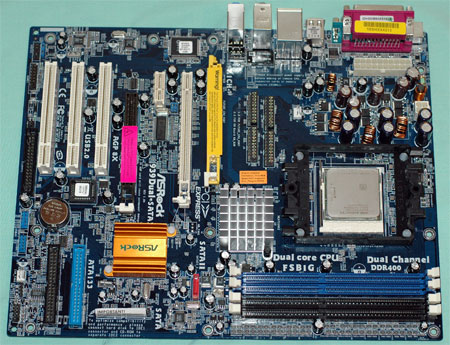
Original Link: https://www.anandtech.com/show/1782
ASRock 939Dual-SATA2: First Retail ULi PCIe/AGP
by Wesley Fink on September 7, 2005 12:05 AM EST- Posted in
- Motherboards
Many have been looking forward to the arrival of the first ULi chipset retail motherboards since our review of the ULi Reference boards. In the first Reference board review and the updated second ULi Reference, we found uncompromised performance with both the PCIe and AGP 8X graphics slots. This is very good news for owners of high-end AGP 8X graphics cards, since for the first time they can buy a board that will run their AGP at full speed now, with provisions for a PCIe video card upgrade in the future. Since we have found no real performance difference in PCIe and AGP cards of the same type, the ULi M1695/M1567 chipset provides fresh new options for many end users.

Board Layout: ASRock 939Dual-Sata2

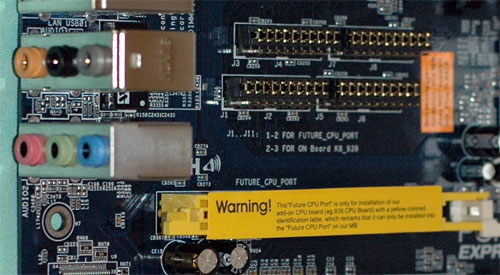
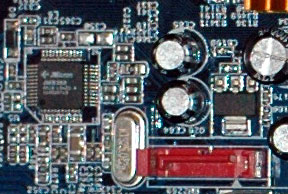
The 20-pin (not 24-pin) ATX connector and 4-pin 12v connector are located between the CPU socket and the IO ports on this 3-phase board. This is not the most ideal location, but with both connectors near the board edge, it works well.
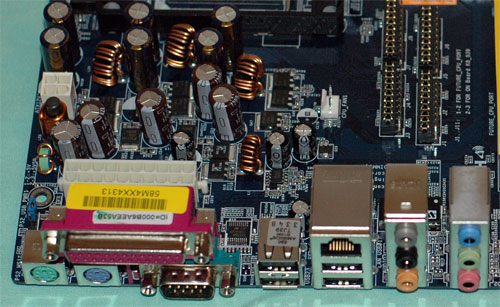
Value boards often present challenges in board layout to the end-user. Since the selling price is usually of foremost importance, the layout is often geared to efficient manufacturing more than end-user convenience.
The ASRock 939Dual-SATA2 is generally well laid out. Some thought clearly went into connector placement, but there are a few glaring oversights. The floppy and IDE connectors were hard to work with in a mid-tower case in light of their bottom right location. A standard IDE cable would barely make it from a top-mounted optical drive to IDE2. The floppy at the center bottom is particularly troublesome if you still use a floppy drive. If you don't, then it's a moot point.
You can clearly see the Asus heritage in the fact that ASRock uses only passive heatsinks on the 939Dual. Certainly, this is the best solution where noise is a concern, but it does not always provide for the most efficient cooling. Our experience during testing and overclocking the ASRock was that the Northbridge became pretty warm, but not warm enough to cause a shutdown or reboot.
Basic Features: ASRock 939Dual-Sata2
| ASRock 939Dual-SATA2 | |
| CPU Interface | Socket 939 Athlon 64 Future CPU Upgrade Slot for AMD M2 |
| Chipset | ULi M1695 Northbridge - ULi M1567 Southbridge |
| BUS Speeds | 200 to 400Mhz in 1MHz Increments |
| PCIe Speeds | 75-125MHz in 1MHz Increments Selected Frequency, Synchronous or Asynchronous (Fixed) to CPU Speed |
| PCI/AGP | Fixed at 33/66 |
| Core Voltage | Auto, 0.80V to 1.55V in 0.025V increments |
| CPU Clock Multiplier | Auto, 4x-21x in 1X increments |
| HyperTransport Frequency | 1000MHz (1GHz) |
| HyperTransport Multiplier | Auto, 200, 400, 600, 800, 1000 |
| DRAM Voltage | Auto, Normal, High |
| HyperTransport Voltage | NO Adjustments |
| Memory Slots | Four 184-pin DDR DIMM Slots Dual-Channel Configuration Regular Unbuffered Memory to 4GB Total |
| Expansion Slots | 1 PCIe x16 1 AGP 8X 1 PCIe x1 3 PCI Slots |
| Onboard SATA/RAID | 2 SATA1 Drives by ULi M1567 (RAID 0, 1, JBOD) 1 Sata2 NCQ 3Gb/s Drive by JMicron JMB360 |
| Onboard IDE/IDE RAID | Two Standard ATA133/100/66 (4 drives) |
| Onboard USB 2.0/IEEE-1394 | 8 USB 2.0 ports supported by ULi M1567 No Firewire (Optional) |
| Onboard LAN | 10/100 Ethernet by ULi & Realtek PNY |
| Onboard Audio | AC '97 2.3 8-Channel by Realtek ALC850 |
| BIOS | AMI 8/12/2005 |
ASRock provides a decent selection of adjustments in the AMI BIOS. Almost everything the enthusiast needs to squeeze a bit more from the CPU is available in the BIOS options. This includes CPU ratios, CPU voltage adjustments, memory timing adjustments, CPU clock speed adjustments, and PCIe speed adjustment. There is even a crude, but effective option for memory voltage - which just offers normal, high and auto settings. Fortunately, the High setting must be around 2.8V, since it was effective with our standard Samsung TCCD test memory.
CPU voltage has a wide adjustment range down, but it's a bit lacking at the top. The 130nm Clawhammer stock is 1.5V, and 1.55V is the top option with this chip. Install a 90nm 4800+ X2, with a 1.35V default voltage, and the top voltage slides to 1.40V. This .05V voltage range at the top is not really adequate for many users. The wide 200 to 400 CPU speed range is plenty, as is the 75-125 PCIe range and asynchronous PCIe option.
The ASRock would move from adequate to outstanding with a few additions to the BIOS. The ULi chipset is too good not to offer a wide range of memory voltage adjustments. It would also be useful to have CPU voltage extend to at least 1.65 to 1.7V, even if this requires a ULi motherboard with the Asus brand instead of ASRock.
The good news is the limited DRAM "high" setting does work well with most common RAM. The ASRock also has no problem with Athlon x2, FX, or other Socket 939 CPUs.
We did find extremely irritating cold boot issues with the ASRock in our testing. Even at standard stock speeds and settings, the 939Dual often required several starts to boot. Perhaps this was due to some setting in BIOS, but we could never discover the source of the cold boot issue. Overclocking seemed about the same with cold boot issues as stock operations. This kind of problem is often fixable with a BIOS upgrade and we hope that ASRock will address the cold boot issues very soon. It's a shame to have a board this good plagued with annoying cold boot issues.
UPDATE: ASRock has released BIOS 1.20 dated 9/02/05 which can be downloaded from their web site. Version 1.20 fixed the cold boot problems we experienced.
Overclocking: ASRock 939Dual-Sata2
| Front Side Bus Overclocking Testbed | |
| Processor: | Athlon 64 4000+ (2.4GHz, 1MB Cache) |
| CPU Voltage: | 1.55V (default 1.50V) |
| Cooling: | Thermaltake Silent Boost K8 Heat sink/Fan |
| Power Supply: | OCZ Power Stream 520W |
| Memory: | OCZ PC3200 EL Platinum Rev. 2 (Samsung TCCD Memory Chips) |
| Hard Drive: | Seagate 120GB 7200RPM SATA 8MB Cache |
| Maximum OC: (Standard Ratio) |
242x12 (4x HT, 2.5-3-3-7, "High" voltage) 2904MHz (+21%) |
| Maximum FSB: (Lower Ratio) |
304 x 9 (2736MHz) (3x HT) (2 DIMMs in DC mode) (+52% Bus Overclock) |
We certainly didn't expect much with just "Normal" and "High" choices for memory voltage, but the ULi chipset has surprised us once again. We easily reached 242 at stock 12x multiplier - one of the highest overclocks that we have seen with this CPU.
As we saw on the ULi Reference board 2, we could reach all the way to 400 Clock Speed with reduced multipliers and lowered memory ratios. Using our standard OCZ TCCD at rated speed, we still managed to reach above 300, making the ASRock one of the few AMD motherboards that can reach beyond 300 with this memory.
Memory Stress Testing
Our memory stress test measures the ability of the ASRock 939Dual to operate at its officially supported memory frequency (400MHz DDR), at the lowest memory timings that OCZ PC3200 Platinum Rev. 2 modules will support. All DIMMs used for stress testing were 512MB double-sided (or double-bank) memory. To make sure that memory performed properly in Dual-Channel mode, memory was only tested using either one dual-channel (2 DIMMs) or 2 dual-channels (4 DIMMs).We had established in our initial reviews of the ULi chipset that the best memory performance was achieved at a tRAS setting of 10T with this chipset. Therefore, all testing used the best performing 2-2-2-10 settings.
| Stable DDR400 Timings - One Dual-Channel (2/4 DIMMs populated) |
|
| Clock Speed: | 200MHz |
| CAS Latency: | 2 |
| RAS to CAS Delay: | 2T |
| RAS Precharge: | 10T |
| Precharge Delay: | 2T |
| Command Rate: | 1T |
Using two DIMMs in Dual-Channel 128-bit mode, the memory performed in all benchmarks at the fastest 2-2-2-10 timings at default voltage.
| Stable DDR400 Timings – 4 DIMMs (4/4 DIMMs populated) |
|
| Clock Speed: | 200MHz |
| CAS Latency: | 2.0 |
| RAS to CAS Delay: | 2T |
| RAS Precharge: | 10T |
| Precharge Delay: | 2T |
| Command Rate: | 2T |
Tests with all four DIMM slots populated on the ASRock 939Dual-SATA2 required a 2T Command Rate with 4 DIMMs in two dual channels. This is the pattern seen on every other top-performing Socket 939 board. This performance is completely competitive with the best that we have seen on nForce4 motherboards for Socket 939. It needs to be pointed out, however, that cold boot problems increased significantly when running 4 DIMMs. The cold boot issue may be as simple as a revised BIOS to support Samsung TCCD better on this board. Whatever the solution, solving the cold boot issue is a must for ASRock.
Test Setup
| Performance Test Configuration | |
| Processor(s): | AMD Athlon 64 4000+ (2.4GHz) Socket 939 |
| RAM: | 2 x 512MB OCZ PC3200 Platinum Rev. 2 |
| Hard Drive(s): | Seagate 120GB 7200 RPM SATA (8MB Buffer) |
| Video AGP & IDE Bus Master Drivers: | NVIDIA nForce 6.66 |
| Video Cards: | NVIDIA 6800 Ultra (PCIe) NVIDIA 6800 Ultra (AGP) |
| Video Drivers: | NVIDIA nForce 77.77 |
| Operating System(s): | Windows XP Professional SP2 Direct X 9.0c |
| Motherboards: | ASRock 939Dual-SATA2 (ULi M1695/1567) Sapphire A9RX480 (ATI) Jetway 939GT4-SLI-G (nForce4) ULi AP9567A (M1695/M1567) Abit An8 Fatal1ty Biostar NF4UL-A9 Chaintech VNF4-Ultra DFI LANParty UT nF4 Ultra-D ECS KN1 Extreme Epox 9NPA+ Ultra Winfast NF4UK8AA (Foxconn) Asus A8N-SLI Deluxe DFI LANParty nF4 SLI-DR Gigabyte K8NXP-SLI MSI K8N Neo4/SLI Platinum |
Tests used OCZ PC3200 Platinum Rev. 2, which uses Samsung TCCD chips. All memory ran at the best timings for the chipset in all benchmarks. This means 2-2-2 base timings with the optimal tRAS for the tested chipset - 7 for nForce4/ATI Rx480, and 10 for ULi.
The NVIDIA 6800 Ultra was used for testing both PCIe and AGP performance on the ASRock board, the ULi Reference board, and the Biostar. The 6800 Ultra video cards were tested at the same video timings and differed only in interface - AGP or PCIe. Resolution in all benchmarks is 1280x1024x32 unless otherwise noted.
Results for the ULi chipset boards are in orange for AGP and red for PCIe.
General Performance & Encoding
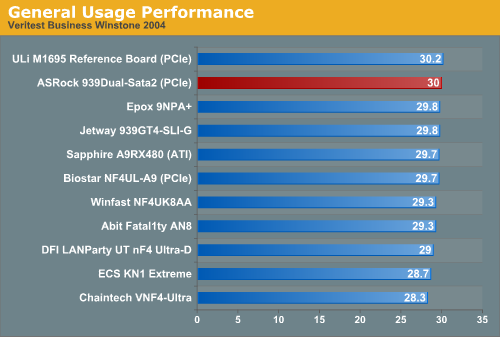
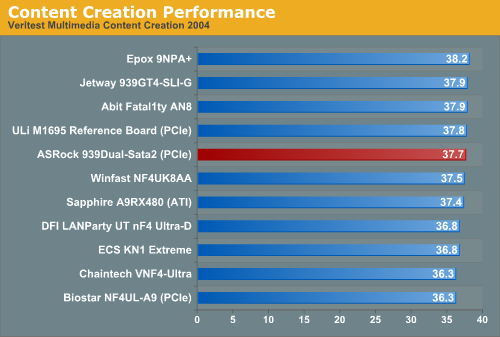
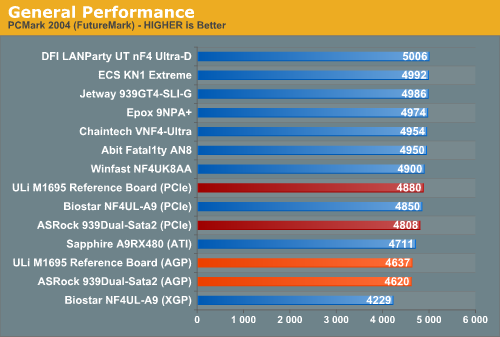
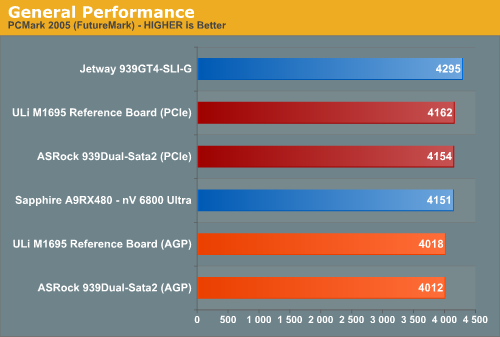

The ASRock performs well in General Performance and Encoding benchmarks. Performance is on par with test results from the ULi Reference Boards. Both AGP and PCIe graphics performance is competitive, with patterns similar to the AGP/PCIe results seen with the Reference Boards.
Overclocking Comparison
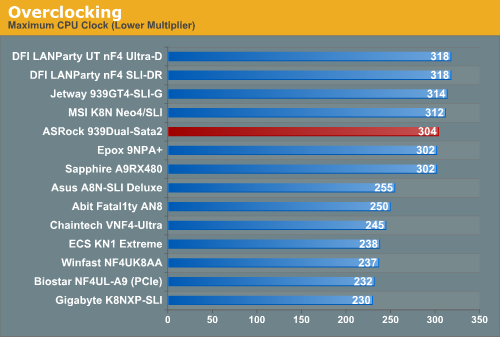
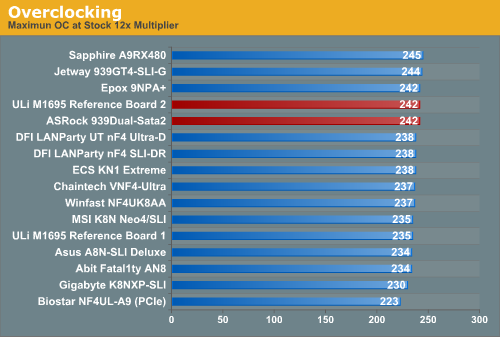
Gaming Performance
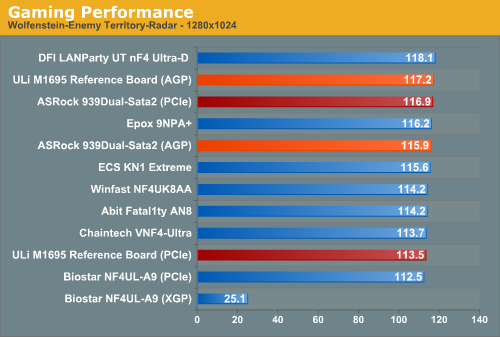
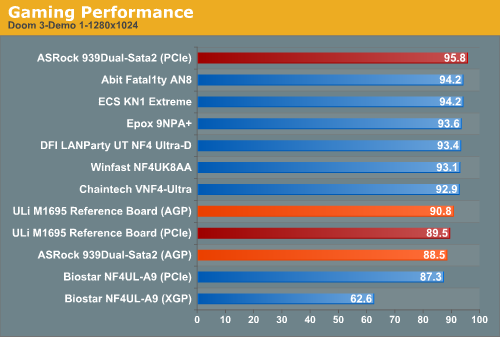
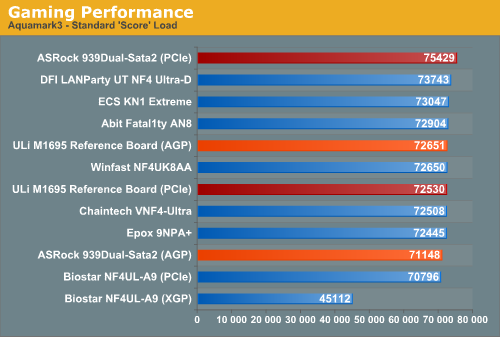
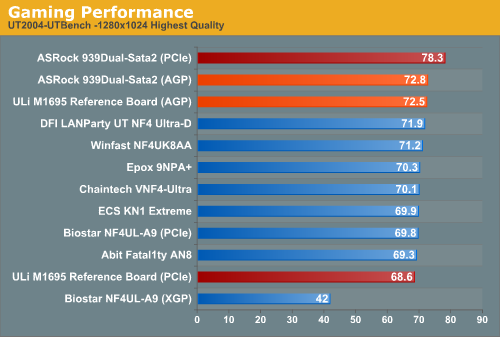
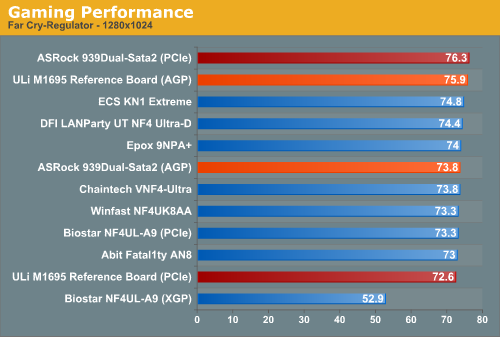
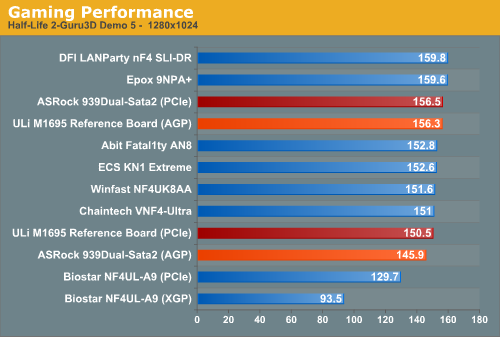
There were no glaring deficiencies in gaming when we tested the ULi Reference Boards, but we were surprised that AGP outperformed PCIe and wondered aloud whether some future manufacturer would better tune the PCIe performance. If you look carefully, it's clear that ASROCK has done just that. AGP performance is a bit lower than the outstanding results that we achieved with the ULi Reference, but PCIe has now risen to the top of the charts. PCIe gaming results are now among the best that we have seen with any AMD Socket 939 board.
It is clear, after our testing of both ULi Reference and ASRock boards, that the ULi M1695/M1567 is capable of both top AGP performance and top PCIe performance. This means the ULi boards have proven that they can be tops in both areas. The capabilities are there with the ULi chipset, but it is up to the manufacturer to tweak the BIOS and/or board to achieve top performance.
Final Words
Almost everyone likes a story where the little guy wins - David beats Goliath. The little guy comes up with a unique and useful product or tops the Performance charts with a new chipset. Certainly, the ULi M1695/M1567 is just such a success story.Many buyers were begging for a PCIe board that would also support AGP, without compromise. Lots of companies tried and the market ended up with a lot of compromised solutions that didn't catch on. It took ULi to finally build the chipset that made top-performing AGP on a PCIe board a reality.
More than that, the ULi M1695/M1567 chipset does not need to apologize to any other chipset in its performance. The ASRock 939Dual-SATA2 shows a retail product that is as good, or even better, than the ULi Reference Boards that excited those sites that actually bothered to look at the ULi chipset with an open mind.
The ASRock is clearly a value board, designed to sell for a low price, but even so, it provides all the features, including SATA2 with NCQ, that you would expect on an up-to-date A64 motherboard. The ASRock is by no means perfect. The layout will be a pain for some, the cold boot issues are annoying, LAN is 10/100 and not Gigabit, and there are no Firewire ports. But the ASRock does so much, so well that it is easy to forgive the warts when you consider the selling price. We sincerely hope that ASRock will invest a bit more time in refining the 939Dual-SATA2. With a refined BIOS and expanded memory voltage adjustments, this board could be a monster hit for ASRock. It will likely sell very well regardless, as many will also notice the slot for a future M2 expansion board.
UPDATE: ASRock has released BIOS 1.20 dated 9/02/05 which can be downloaded from their web site. Version 1.20 fixed the cold boot problems we experienced.
We like the ASRock and its implementation of the ULi chipset. It is an easy board to recommend - especially in the value and mid-range segments. We are still looking, however, for the ULi chipset from Abit or Gigabyte or Albatron or DFI - or even ASUS - that will really squeeze everything possible from the ULi chipset. Hopefully, such a board is just around the corner.
For now, if you have a top AGP video card that you are not ready to replace, then get an ASRock 939Dual - you will not be disappointed in performance and you can add PCIe whenever. Even if you don't care about AGP, the PCIe performance of the ASRock will not disappoint. ULi has brought a capable, competitive chipset to the AMD Socket 939 market. It is a fully competitive choice for any buyer, a must for AGP owners, and more is on the way from ULi. The ASRock is a very good value board and we are looking forward to what can be done with this chipset on a board aimed at the enthusiast.

